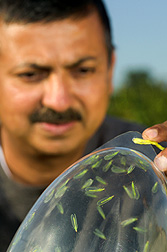This page has been archived and is being provided for reference purposes only. The page is no longer being updated, and therefore, links on the page may be invalid.
|
Read the magazine story to find out more. |
|
|
|
|
"Cologne" Attracts Beneficial Lacewing Predators
By Rosalie Marion BlissJune 4, 2007
A new lure being developed by scientists with the Agricultural Research Service (ARS) and their collaborators could bring relief to growers trying to guard crops and gardens against aphids and mites. The lure is a natural product that attracts lacewings, a beneficial predator that enjoys devouring destructive aphids and mites.
Chemist Kamal Chauhan and entomologist Jeffrey Aldrich, with the Chemicals Affecting Insect Behavior Laboratory, Beltsville, Md., led the project. Chauhan used the laboratory's patent-pending separation method to extract the key compound—iridodial—from catnip oil.
Laboratory tests showed that the iridodial prepared from catnip extract matches the chemical structure of the male lacewing's pheromone. The attracting vapor-like substance is emitted from thousands of glands that cover the male's tiny abdomen. The separation method offers an economical way to make large amounts of this insect "cologne" that attracts several lacewing species.
Organic farmers and growers purchase lacewings as eggs or larvae to protect crops from aphids and mites. Results from a 2-year field study showed that iridodial attracts both male and female lacewings that later produce another generation of beneficial predators. So a commercial formulation based on iridodial could relieve farmers of the need to repeatedly buy and release beneficial insect larvae.
Iridodial is very potent; just 25 milligrams is sufficient to treat an acre of land. Another advantage is that the attractant is environmentally benign and remains active for five weeks, degrading slowly.
Chauhan is now working with Spokane, Washington-based Sterling International to commercialize formulations that attract specific beneficial insects.
Read about this research in the May/June 2007 issue of Agricultural Research magazine.
ARS is the U.S. Department of Agriculture's chief scientific research agency.

